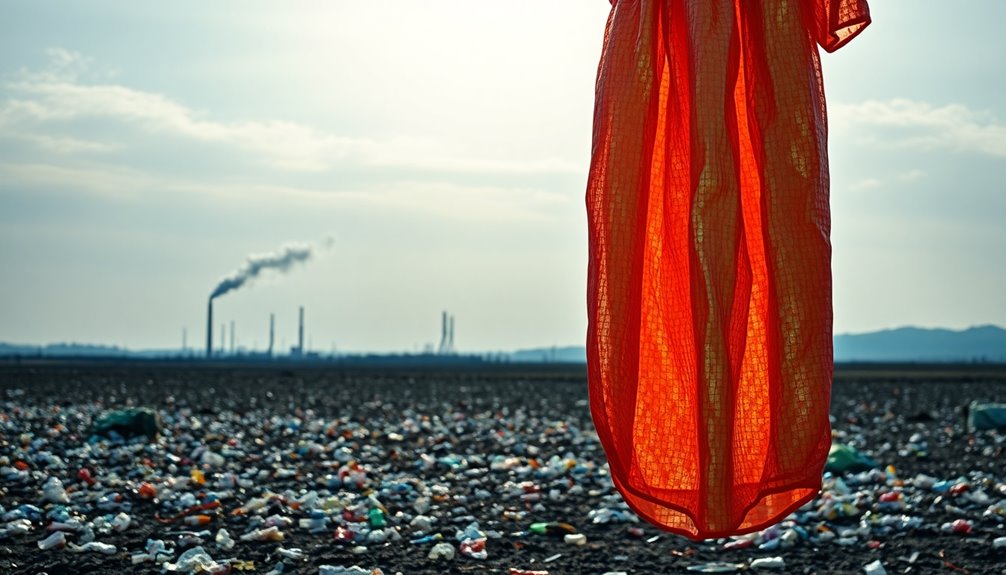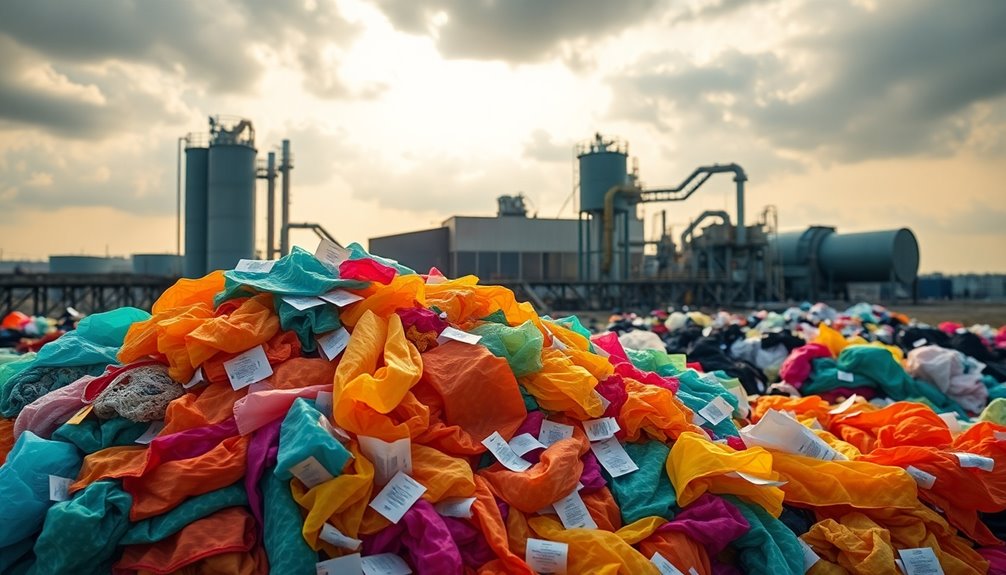Polyester might seem appealing due to its affordability and durability, but it's far from sustainable. Its production considerably contributes to carbon emissions, uses vast amounts of water, and releases harmful microplastics into our waterways. Only a tiny fraction gets recycled, while most ends up in landfills. As consumers become more aware of these impacts, the demand for transparency and alternative materials grows. Discover what steps the fashion industry is taking to address these challenges.
Key Takeaways
- Polyester is highly durable and affordable, making it popular in fast fashion, but its production is environmentally damaging, emitting significant CO2 and consuming large resources.
- The production process releases untreated wastewater with harmful chemicals, contributing to pollution and environmental degradation.
- Washing polyester garments releases microplastics into waterways, posing threats to marine life and human health through bioaccumulation.
- Recycling polyester remains a challenge, with less than 1% of garments being recycled, primarily due to technical and economic barriers.
- Growing consumer demand for transparency and sustainable practices is pushing brands to explore alternatives and adopt circular fashion principles to minimize waste.
The Origins of Polyester: A Synthetic Revolution

Although you mightn't think about it often, the origins of polyester mark a significant turning point in the textile industry. Developed in the early 1940s by British chemists John Rex Whinfield and James Tennant Dickson, polyester introduced a new era of synthetic materials. Its affordability and durability quickly caught on in the fashion industry, revolutionizing how clothes were produced.
However, this synthetic fiber has a dark side. Derived from petroleum, polyester contributes to environmental challenges linked to fossil fuel extraction and production, leading to significant carbon emissions and pollution.
With polyester accounting for about 80% of all synthetic fiber usage, its long-lasting presence in landfills raises serious questions about its role in sustainable fashion.
The Allure of Polyester in Fast Fashion

You can't ignore the appeal of polyester in fast fashion—it's affordable and accessible, making it easy for everyone to stay trendy.
Its durability and versatility mean you get more wear out of each piece, which seems like a win.
But as you enjoy these benefits, it's crucial to reflect on the broader impact on our environment.
Affordability and Accessibility
As consumers seek trendy and affordable clothing, polyester has emerged as the go-to fiber for fast fashion brands. Its low cost allows companies like Shein and H&M to produce fashionable polyester garments quickly, meeting your desire for instant gratification.
The affordability of polyester enables greater accessibility to stylish options, even for those on a budget.
- Polyester is the most widely-used fiber, making it easy to find.
- It's cheaper to produce than natural fibers, keeping prices low.
- Washing polyester requires less water, enhancing its appeal.
While sustainable clothing remains a concern, the allure of polyester lies in its ability to provide trendy styles without breaking the bank.
You can stay fashionable while maneuvering the complexities of sustainability.
Durability and Versatility
Polyester stands out in the fast fashion world for its impressive durability and versatility. Its ability to resist shrinking, stretching, and wrinkling means your clothes maintain their shape and appearance over time. This durability makes polyester a popular choice among consumers who value practicality.
Additionally, its versatility allows it to blend seamlessly with other fibers, enhancing characteristics like moisture-wicking and quick-drying properties. With polyester making up 80% of the global synthetic fiber market, its affordability and low maintenance contribute to rapid production cycles.
However, while polyester's resource efficiency is appealing, it raises concerns about environmental harm. Ultimately, the long lifespan of polyester garments often leads you to perceive them as a valuable investment in the fast fashion landscape. In contrast, high-quality protein sources in pet food reflect a growing trend toward sustainable ingredient choices.
The Environmental Cost of Polyester Production

When you consider polyester's production, the carbon emissions are staggering, with about 14.2 kg of CO2 released for every kilogram made.
This not only contributes to climate change but also raises serious concerns about water consumption and pollution during the manufacturing process.
As you evaluate your clothing choices, it's crucial to understand the hidden environmental costs tied to polyester.
Carbon Emissions Impact
While many people enjoy the affordability and versatility of polyester, its production comes with a hefty environmental price tag.
Polyester production emits around 14.2 kg of CO2 for every kilogram produced, greatly contributing to global carbon emissions. This energy-intensive process requires about 125 MJ per kilogram, further worsening its carbon footprint.
As the backbone of fast fashion, polyester accounts for 80% of synthetic fiber usage, linking it directly to fossil fuels and climate change.
- High carbon emissions exacerbate global warming.
- Reliance on nonrenewable resources harms the environment.
- Fast fashion accelerates the cycle of consumption and waste.
If you're aiming for sustainable fashion, reconsider the impact of polyester on our planet.
Water Consumption Concerns
Although many appreciate the affordability of polyester, the water consumption involved in its production raises significant environmental concerns.
Polyester production requires around 200 liters of water for every kilogram of textiles created, leading to alarming water usage statistics. For instance, producing just one pair of jeans demands about 3,781 liters of water, highlighting the textile industry's impact on water scarcity.
This excessive water footprint not only strains local resources but also contributes to pollution, as untreated wastewater often contains toxic chemicals harmful to aquatic life.
As you consider sustainable fashion options, recognize that polyester's environmental cost extends beyond its carbon emissions, making it essential to weigh its water consumption against your values and the planet's health.
The Microplastic Crisis: Polyester's Hidden Impact

As you wash your polyester garments, it's easy to overlook the unseen consequences of your laundry routine. Each cycle releases millions of microplastics into waterways, threatening marine life and ecosystems.
These tiny polyester fibers can be ingested by marine organisms, leading to bioaccumulation in the food chain and posing serious health effects for you and others.
- Microplastics can be found in your drinking water.
- Shellfish and salt often contain these harmful particles.
- Polyester doesn't biodegrade easily, persisting in landfills for decades.
Recycling Polyester: Challenges and Limitations

The impact of polyester extends beyond microplastics in our oceans; it also presents significant challenges when it comes to recycling. Less than 1% of collected polyester clothing is actually recycled into new garments, revealing inefficiencies in the production processes. Most recycled polyester comes from water bottles instead of used garments, highlighting a gap in garment recycling efforts.
| Challenge | Description |
|---|---|
| Low Recycling Rate | Less than 1% of polyester clothing is recycled. |
| Source of Material | Mainly from bottles, not used garments. |
| Technical Challenges | Difficulties in separating blended fabrics. |
| Economic Viability | Technologies aren't economically feasible yet. |
| Environmental Impact | Landfilled polyester releases harmful chemicals. |
These factors complicate recycling polyester, leading to down-cycling rather than true reuse.
The Role of Consumer Awareness in Sustainable Fashion

As you become more aware of the environmental impact of your fashion choices, your purchasing habits may shift towards sustainability.
By demanding transparency from brands, you can encourage them to adopt eco-friendly practices.
Understanding the consequences of materials like polyester empowers you to make informed decisions that benefit both the planet and your wardrobe.
Understanding Environmental Impact
While many people enjoy the convenience and affordability of polyester, understanding its environmental impact is essential for making informed fashion choices.
Polyester production emits around 14.2 kg of CO2 per kilogram, markedly contributing to greenhouse gas emissions. Additionally, every wash releases millions of microplastics that pollute waterways and harm marine life.
It's alarming that the average person ingests about 1,769 plastic particles weekly, primarily from synthetic fibers like polyester.
To promote sustainable fashion, reflect on these points:
- Less than 1% of collected polyester clothing is recycled.
- Increased consumer awareness has led 66% of people to contemplate sustainability in their purchases.
- Shifting towards recycled and sustainable alternatives can help reduce this environmental impact. Moderation in butter consumption is essential for balancing indulgence with health-conscious choices in dietary habits.
Shifting Purchasing Habits
Your shifting purchasing habits reflect a growing awareness of the environmental impact of polyester and fast fashion. When you choose brands that emphasize sustainable practices, you actively support efforts to reduce microplastic pollution and promote eco-friendly materials.
A 2019 McKinsey survey showed that 66% of consumers, particularly millennials, prioritize sustainability in their fashion choices. As you opt for brands that align with these values, you contribute to a collective demand for change, encouraging the industry to adopt more responsible methods.
Initiatives like the Fossil Fashion Campaign highlight the need to decrease fossil fuel usage in production processes. Your informed decisions can lead to a more sustainable and conscious fashion future. Furthermore, the rise of AI in marketing allows brands to better understand consumer preferences and promote sustainable options effectively.
Demand for Transparency
Increasingly, consumers are demanding transparency from fashion brands, recognizing that their choices have a direct impact on sustainability.
With 66% of shoppers considering sustainability in their purchases, it's clear that you want to know more about the production process behind your clothes. This growing demand for transparency is vital, especially regarding materials like polyester, which can contribute to textile pollution.
- Understand the environmental impact of your clothing.
- Support brands that openly share their sourcing and production methods.
- Help push for regulations like Extended Producer Responsibility (EPR) to hold brands accountable. Additionally, consumers can benefit from understanding the health benefits associated with low-emission materials in their clothing choices.
Exploring Alternative Materials: Beyond Polyester

As the fashion industry seeks more sustainable options, exploring alternative materials beyond polyester reveals a complex landscape of environmental impacts.
While organic cotton is popular, it requires significant water and land resources, reminding us that sustainability challenges exist across different fiber types.
Innovations like hemp and Tencel are emerging as viable alternatives, offering biodegradability and a lower environmental footprint compared to traditional synthetic fibers.
Recycled polyester, derived from post-consumer plastic bottles, is currently the most common alternative, making up about 14% of polyester production.
Additionally, ongoing research into biodegradable textiles aims to develop materials that break down at the end of their life cycle, helping reduce landfill accumulation and creating a more sustainable future for fashion. Furthermore, exploring options like chia seeds can provide insights into sustainable practices in other industries, emphasizing the importance of nutrient-rich, low-impact materials.
The Shift Towards Circular Fashion Practices

Shifting towards circular fashion practices is a significant step in addressing the sustainability challenges faced by the industry.
By focusing on longevity, reuse, and recyclability, you can help minimize waste and reduce reliance on virgin polyester. With current recycling rates for polyester below 1%, it's clear that innovative systems are indispensable.
Consider these key elements:
- Recycled Polyester: Using materials like recycled water bottles can transform your wardrobe sustainably.
- Extended Producer Responsibility (EPR): Encouraging brands to manage their products' end-of-life fosters a circular economy.
- Supply Chain Innovations: Developing technologies to separate blended fabrics is essential for efficient recycling.
Industry Innovations: Reducing Polyester Dependency

While the fashion industry grapples with its environmental impact, innovative solutions are emerging to reduce dependency on virgin polyester. Companies like TAL Apparel are leading the charge by using recycled polyester from bottles, with about 14% of polyester now produced from recycled fibers. The Hong Kong Research Institute is tackling the challenge of separating mixed materials for effective polyester recycling. Additionally, custom clothing solutions from brands like Amazon and Unspun reduce waste by producing on-demand garments. The Green Machine technology is enhancing recycling capabilities, making reuse more viable. Brands are also committing to eliminating polyester from their supply chains in the next 5 to 10 years, promoting a shift toward sustainable materials. Furthermore, advanced technology is crucial in improving recycling processes and enhancing overall sustainability in the fashion industry.
| Innovation | Impact |
|---|---|
| Recycled Polyester | Reduces virgin polyester dependency |
| Mixed Material Separation | Improves polyester recycling efficiency |
| On-Demand Production | Minimizes excess inventory |
| Green Machine Technology | Enhances economic viability of recycling |
| Supply Chain Commitments | Encourages sustainable materials usage |
The Path to Sustainable Fashion: Collaborative Solutions

To create a truly sustainable fashion industry, collaboration among brands, consumers, and policymakers is essential.
By working together, you can address issues like overproduction and reliance on virgin polyester, ultimately lowering production costs and reducing waste.
Here are some collaborative solutions to contemplate:
- Support the Fossil Fashion Campaign's goal of reducing emissions by 55% by 2030.
- Advocate for innovative recycling technologies that separate mixed materials for improved recycling outcomes.
- Embrace custom clothing solutions to minimize excess inventory and overproduction.
Prioritizing long-term environmental responsibility over immediate profits fosters an industry-wide commitment to sustainable fashion. Additionally, understanding the impact of family dynamics on consumer choices can further enhance these collaborative efforts.
Frequently Asked Questions
Why Is Polyester Not Sustainable?
Polyester isn't sustainable because its production emits a significant amount of CO2 and consumes a lot of energy.
It doesn't biodegrade, so it sits in landfills for decades, polluting the environment.
Plus, when you wash polyester, it sheds microplastics that harm marine life and ecosystems.
Recycling rates are low, and most recycled polyester comes from bottles, not old clothes.
The harmful chemicals released during production and disposal further threaten both the environment and human health.
Why Shouldn't You Wear Polyester?
You might think wearing polyester's a walk in the park, but it comes with serious downsides.
This fabric's derived from fossil fuels, contributing markedly to greenhouse gas emissions. Plus, when you wash it, microplastics leach into waterways, harming marine life.
Once it's in a landfill, polyester sticks around for decades, adding to pollution.
Should I Throw Away Polyester Clothes?
You shouldn't throw away polyester clothes. Instead, consider donating or selling them to give them a second life.
Most polyester items end up in landfills, where they can linger for decades and release harmful chemicals.
Look into local recycling initiatives or brands that offer take-back programs to dispose of them responsibly.
Why Does Polyester Have a Bad Reputation?
Polyester's like a double-edged sword; it offers comfort but cuts deep into our planet's health.
Its bad reputation stems from its environmental toll—massive carbon emissions during production, plastic microfibers polluting our waters, and a stubborn refusal to biodegrade.
When you wear polyester, you're not just donning a garment; you're wrapping yourself in a layer of controversy.
This fabric's convenience often masks the serious ecological consequences that follow in its wake.
Conclusion
As you navigate the complex world of fashion, think of polyester as a double-edged sword—shiny and appealing on the surface, but capable of cutting deep into the fabric of sustainability. While it's tempting to embrace the quick thrills of fast fashion, remember that true style weaves together responsibility and innovation. By choosing wisely and supporting circular practices, you can transform your wardrobe into a tapestry of environmental consciousness, stitching together a brighter future for fashion.









